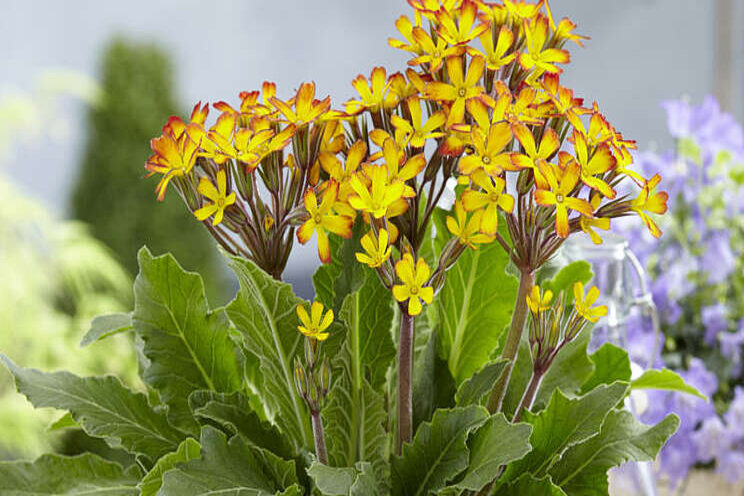Culture Report: Primula 'Oakleaf Yellow Picotee'
Added on 29 June 2020

Primula vulgaris 'Oakleaf Yellow Picotee' is a unique plant, offering many great improvements over other cultivars of this genus. Its unusual shaped leaves provide a wonderful backdrop to the cheerful flowers of bright yellow with red edges. This cultivar offers sturdy stems and long bloom periods in much of the country. In many areas, it is a continuous bloomer, flowering from mid February through April.
Oakleaf primula was first discovered in the late 1990s by Dr. Richard Brampton in Nottingham, United Kingdom. At the time of its discovery nothing resembling this form had been documented.

Primula vulgaris is popular with growers as it is one of the earliest flowering perennials. In the garden, it performs best in a cool, part shade to full shade area. It also provides an early source of nectar for bees and other pollinators.
'Oakleaf Yellow Picotee' is an easy, carefree cultivar with green oak-leaf shaped foliage. The flowers rise above the leaves to add visual interest. This type of primrose has a hardiness to Zones 4 through 9. It measures approximately 12 to 16 inches tall and 14 inches wide.
With its vigorous, yet compact habit, and extended bloom time, Oakleaf is very versatile and well suited for use in the landscape or early season patio containers.
PROPAGATION
Like many new perennial varieties, Oakleaf is vegetatively produced by means of tissue culture. Tissue culture has allowed this and many other new varieties to reach the market in a relatively short period of time. It is a patented variety and self propagation is prohibited. When growing primula Oakleaf from tissue culture, it is best to start your tissue culture in late spring/ early summer.
It is recommended to grow in a paper plug. Suggested size is 72 cell or similar. Moisten the growing media prior to sticking the tissue culture. Rooting occurs best when they are propagated at 65 to 68° F with a fog system.
During this period, maintain mid to moderately dry moisture levels, being careful to not allow TC to dry out or become saturated.
Once true leaves are present, apply 75- to 100-ppm nitrogen every third watering or 50 ppm of a well-balanced water-soluble each watering is suggested. The pH should be maintained at 5.5 to 6.2. Primula are sensitive to high light levels. To prevent burning, provide 30 to 50% shade when natural light exceeds 3,000 foot-candles.
Liners take approximately nine weeks from sticking to become fully rooted and ready for transplanting.
PRODUCTION
Primula vulgaris will typically be transplanted in late summer/early fall. At this point, the plants should have at least five leaves.
Oakleaf prefers to be grown in a well-drained growing media that includes slow-release fertilizer.
When transplanting, the liners should be planted even with the growing media of the new container. EC levels of 0.5 to 0.7 and a pH of 5.5 to 6.0 are optimum.
TEMPERATURES
For the first 10 weeks after potting, maintain a temperature of 45 to 48° F. After this period and sufficient rooting has taken place, the temperature should be reduced to 37 to 41° F. Ventilation is recommended if temperatures exceed 43° F.
Good air circulation and use of the ventilation is key. In areas of damp and dark weather where the plants have developed buds, set the heat to 68 to 72° F.
LIGHTING
Oakleaf will flower naturally as day length extends. To promote early flowering, adding supplemental lighting will help achieve this goal.
FERTILIZATION
For the first eight to 10 weeks after transplant, it is recommended to fertilize at each watering using a complete mix that includes trace elements in a ratio N:K of 1:1 to 1:2. Note: Add iron chelate to the water two or three times during this period. The EC should be in the range of 1.5 to 2.5, depending on the EC in the pot (0.5 to 0.7), and the pH should be in the range 5.5 to 6.0.
Once the buds start to develop, adjust the fertilizer to the rate N:K of 1.2 to 1.3. EC level in the pot should be in the range 1.0 to 1.1.
IRRIGATION
Watering in the morning is important so the plants have time to dry before nightfall. Until the roots reach the edge of the pot, watering overhead will encourage good growth and root development. Then keep the soil relatively dry (moisture will still be present). This will help keep the plants compact and increase resilience.
GROWTH REGULATION
Typically, Oakleaf does not require a growth regulator. If needed, applying a PGR containing propiconazole or daminozide may be useful. Also, lowering the temperature and ensuring the plants are dry at night will help control plant habit.
INSECTS AND DISEASES
Aphids, thrips, whitefly and fungus gnats, leaf miner, and caterpillar are known concerns of Primula vulgaris. Botrytis, bacteria Pseudomonas, leaf spot Ramularia primulae, Thielaviopsis basicola and Mycocentrospora are the most common diseases. It is suggested to spray 10 to 12 days after potting as a preventive measure against mites, fungus gnats and caterpillars.
SCHEDULING
Primula vulgaris 'Oakleaf Yellow Picotee' will typically bloom from early to mid spring. It is a cold-beneficial plant. To obtain the most uniform flowering and the most blooms per plant, it is best to provide vernalization to either large liners or plants in the final container sizes.
PDF: Culture Report: Primula 'Oakleaf Yellow Picotee'
Kathy McKay
Kathy McKay is manager of product development for Flamingo Holland. She can be reached at kathy@flamingoholland.com.
Source and Photo Courtesy of Greenhouse Product News
Source: Greenhouse Product News
More news















